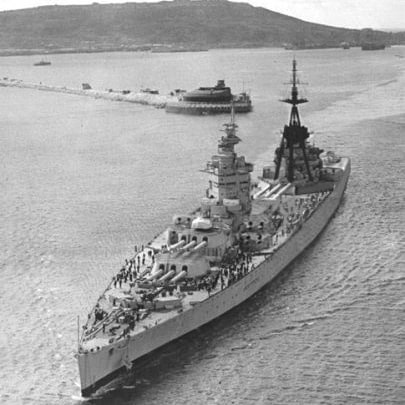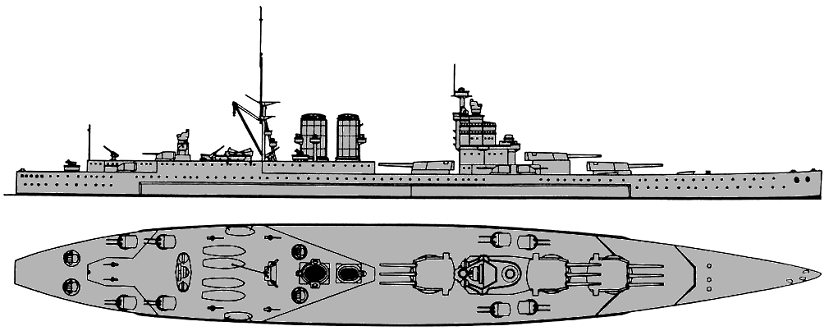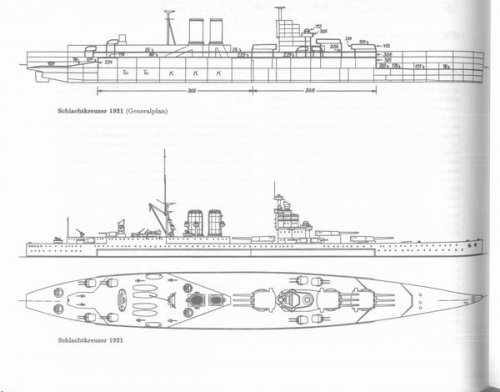-
Yes
-
No
 artist impression of what the G3 would have looked like
artist impression of what the G3 would have looked like

About the suggestion:
The gun the BL 16-inch MK.1 was ordered and began construction before the cancellation of the ship. It would go on to be sheared down and repurposed for the Nelson class Battleships. Furthermore, the keel blocks were worked upon by the John Brown shipyards as well as the hull plates demonstrating the keels were starting to be laid. There is the assertion by several naval historians that the G3’s were laid down. Finally the premise that it was laid down is the entire reason ships like the Lexington class were not finished. Both the US and Japanese governments were satisfied that it was laid down which is why they cancelled their respective projects.
Background
Spoiler
The G-3 Class Battlecruisers were a planned class of 4 Battlecruisers for the Royal Navy in addition to their Half-sister ships the N-3 Class Battleships which were planned to equip the Royal Navy with the premier force of capital ships in the world. Whilst development of the N-3 would be discontinued in the light of the coming naval treaty and economic decline faced by post-war Britain the G-3 development plowed forwards up until their cancellation following the Washington Naval Treaty.
The G-3’s were a response to the aggressive shipbuilding of the US and Japan post-WW1. The US had expressed a desire for naval dominance and the Japanese a complete monopoly over the Pacific theatre should a war break out. Britain, saw these proposals, and decided to come up with a class of ship that blew them out of the water. This would be the G-3.
The ships were to be ordered in a similar manor to Japans eight-eight fleet, but this time of a ‘four-four’ construction, with 4, 18-inch armed Battleships (the N-3) and 4, 16-inch armed Battlecruisers (the G-3). They featured all the teachings of the War and refined British naval strategy. They further were in philosophy a similar design to Yamato in that one ship of either G or N-3 should have been able to battle several peer rivals with overwhelming force. Had they been constructed they would have been similarly comparable to Iowa, though naturally older.
The G-3 faced months of opposition from the Cabinet and Treasury once the design had been finished whilst the Admiralty and notably Winston Churchill pushed forwards as supporters of the class. These ships were to thwart the US plan of building a Navy ‘second to none’ and to reinforce Britain’s place as the world’s premier naval force at the time. The G-3 alone would have been the highest displacing Battlecruiser ever created and would have been more or less equivalent to an Iowa class Battleship, just 20 years younger. Equally G-3 would’ve been faster than any capital ship but Iowa due to her transom stern which became commonplace post-WW2 due to its speed characteristics.
The design was significantly ahead of its time using even an exemplary AA compliment for a design so close to WW1 and would be revised into the Nelson class which was much lighter and slower than the G-3’s.
Specifications
Type: Battlecruiser (Fast Battleship)
Displacement:
48,400 long-tons (Standard)
53.909 long-tons (Deep Load)
Length: 856ft (260.9 m)
Beam: 106ft (32.3)
Draught: 35ft 8in (Deep Load)
Installed power: 160,000shp (120,000kW)
Propulsion: 4 shafts; 4 geared steam turbines
Speed: 32-32.5 knots
Range: 7,000 nautical miles at 16 knots
Crew complement: 1,716
Armament:
-
3 × triple 16 in (406 mm) guns
-
8 × twin 6 in (152 mm) guns
-
6 × single 4.7-inch (120 mm)
-
4 × 8-barrel 2-pdr (40 mm (1.6 in)) mountings
-
2 × 24.5-inch (622 mm) torpedo tubes
Armour:
-
Belt: 12–14 in (305–356 mm)
-
Deck: 3–8 in (76–203 mm)
-
Barbettes: 11–14 in (279–356 mm)
-
Turrets: 8–17.5 in (203–444 mm)
-
Conning tower: 8 in (203 mm)
-
Bulkheads: 10–12 in (254–305 mm)


Construction
Spoiler
There are no photographic primary sources showing the class was laid down such as pictures due to the age of the class, furthermore as they were cancelled, there is even less room for proof of construction. Many tertiary sources repeat the wikipedia assertion (which needs citation) stating that the class was never laid down. However based on an understanding of the political climate just weeks before the Washington Naval Treaty and the imperial treasury, there is evidence to suggest it was in fact laid down.
The G-3 class faced opposition post war as the admiralty had their budget more than halved and the treasury urged them to cut down the capital ship numbers in addition to forbidding the construction (but not development) of any new capital ships. Skipping forward a lot of bureaucracy the rumour that there was a disarmament preposition coming up began to come up following the US’ hard plunge into the depression. This was the Washington Naval Treaty.
The only problem facing the UK with this much revered economic break was the current US and Japanese ships under construction would outclass pretty much anything the Royal Navy fielded outside the Hood. To ensure that these ships would be scrapped and discontinued the G-3 class was retrieved from the backburner to either provide so much of a shock that the nations would be forced to sign the treaty or have to scrap their entire capital ship fleet, or to provide the British with ships to effectively counter these new fleets. Using Admiralty and Imperial funds to finance the ship, the process was rushed just weeks before the Washington Naval Treaty with funds being pulled by the Admiralty and the contract for the ordering of the class of 4 G-3 class Battlecruisers was signed.
There is strong evidence to suggest it was laid down however, firstly that the G-3 class was included in the 1921 Naval Budget and unlike US procurement, ships were purchased and generally considered done-deals. Furthermore the money was indeed pulled, an amount of 2.2 million pounds from the Imperial Dominions and further £15 million from the admiralty itself. Contracts were awarded to the shipyards of John Brown, Swan Hunter and Fairfield on 24 October, and William Beardmore & Co on 1 November. The talks of the Disarmament Treaty began on the 12th of November. Work at John Brown is confirmed to have been done on the keel blocks specifically for this ship class.
The started construction of the G-3’s is in essence what prevented the Japanese Amagi, NO.13-16 and Tosa class ships, as well as the American Lexington, South Dakota and Colorado class ships from being constructed.
Work on the turrets of these ships was started, with them being re-purposed onto Nelson and Rodney, of which the design was only revised after the signing of the treaty. Notice of their eventual suspension also exists.
Given the fact that funds were allocated, materials for the keels purchased, the ships appeared in the defense review and both the US and Japan were satisfied that the ships had in fact been laid down (at least one of them anyway), and given the lack of any primary or secondary sources which say otherwise, I’d say the strongest source is this one: The story behind Britain’s ‘G3’ class battlecruisers - Navy General Board which suggests they were in fact laid down.
And to finally add onto that the Official Battleship New Jersey youtube channel refers to the ships as ‘hardly even laid down’, Drachinfel refers similarly, and Dr Alexander Clarke also refers to them as being laid down.
Sources:
Spoiler
The story behind Britain’s ‘G3’ class battlecruisers - Navy General Board
"G3" project battlecruisers (4)
https://www.youtube.com/watch?v=aT4e-E2CGmE&ab_channel=DrAlexanderClarke
https://www.youtube.com/watch?v=Hpgr0fDVyhI&t=406s&ab_channel=Drachinifel
Washington Cherry Trees II./ Part 3 – Warship Projects 1900-1950
History and Technology - The British 16" Mark I Gun and Mounting - NavWeaps



















